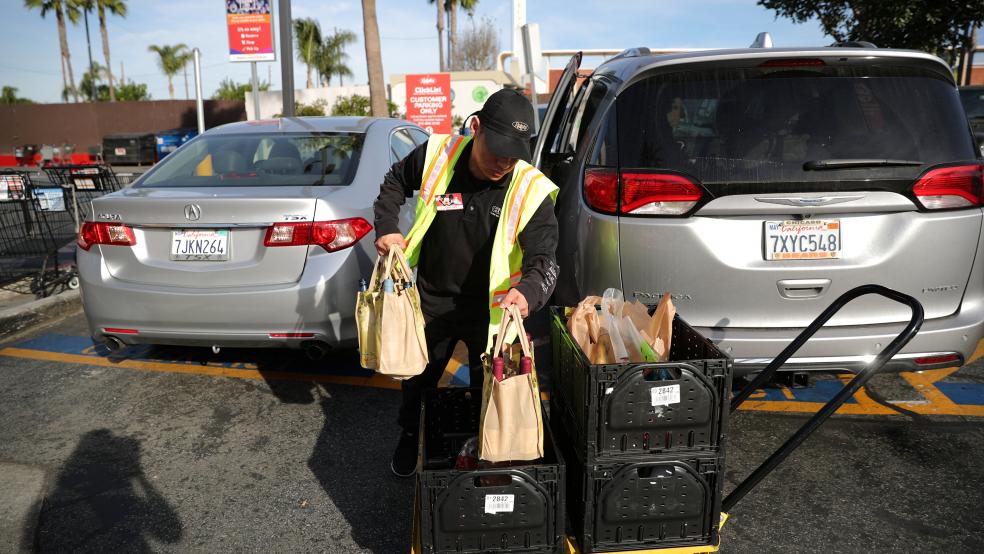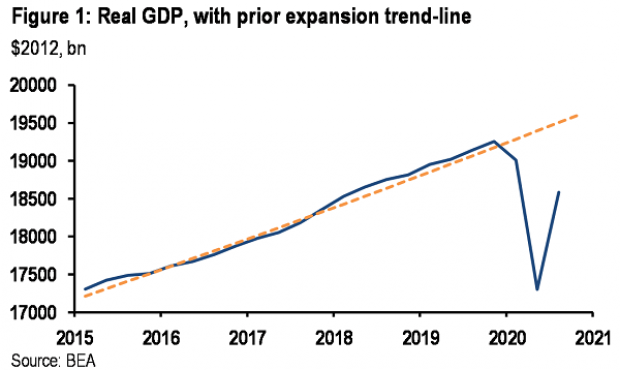The U.S. economy grew at an unprecedented 7.4% pace from the second to the third quarter, the Commerce Department announced Thursday. On an annualized basis, the growth rate was 33.1% — the highest annualized growth rate on record.
The historic growth came on the heels of an equally historic decline the previous quarter, when the economy shrank by 9.1%, or 31.4% on an annualized basis, as businesses closed their doors and people stayed home amid the Covid-19 pandemic.
Although the latest numbers are undoubtedly positive, they come with lots of caveats, as economists took great pains to explain Thursday. Some important points to consider:
The U.S. economy is still in a deep hole: Gross domestic product is still about 3.5% below the level recorded in the fourth quarter of 2019, the last reporting period before the coronavirus pandemic hit, Daniel Vernazza, chief economist at UniCredit Bank, said in a note Thursday.
“That means we are still down almost as much as we were during the height of the Great Recession in 2008-09,” Diane Swonk, chief economist at Grant Thornton, tweeted.
CNBC analyst Ron Insana noted that the economy is now about as big as it was in the first quarter of 2018. “Q3 GDP would have to have been +53% to bring the economy to pre-pandemic levels,” he said. (See the chart from J.P. Morgan below.)
The economy is slowing: The GDP report gives us a look at what was happening from July to September, but conditions have changed since then. While the summer months were powered by business reopenings and a massive flow of federal aid to the unemployed and small business owners, much of that positive momentum has slowed or even reversed. Restrictions on commerce are returning as the coronavirus surges again, and the failure of political leaders to agree on a new round of relief spending means that millions of unemployed workers face sharp reductions in income and spending.
A K-shaped recovery: There are about 11 million fewer people on payrolls than before the pandemic hit, and much of the economic suffering is concentrated among low-income, less-well-educated workers in the service sector. That segment will be especially hard hit by the lack of federal support and a resurgence of the coronavirus and could take years to recover anything like its pre-pandemic levels of employment and income.
Layoffs persist: In a separate report Thursday, the Labor Department announced that 751,000 people applied for state unemployment benefits last week, down 40,000 from the week before. Another 360,000 people made claims Pandemic Unemployment Assistance, the federal program that covers gig workers and the self-employed, bringing the total of new filers to about 1.1 million. While the trend in layoffs, for which new jobless claims serve as a proxy, is positive, falling steadily from record highs in the early days of the pandemic, job losses remain at extraordinarily high levels — higher than we saw at the peak of previous recessions.
Lower expectations for the fourth quarter: Economists don’t expect to see a repeat of the third quarter. Michael Feroli of J..P Morgan said in a note to clients that “a large double-digit increase in 3Q GDP was effectively ‘baked in the cake’ by the time we got to the middle of the summer” thanks to the powerful rebound in consumption throughout the economy. Looking ahead, the data should look more normal, with consumption pushed higher by an elevated savings rate and pulled lower by a resurgent coronavirus. “On net, we are holding on to our 3.0% forecast for 4Q GDP,” Feroli said.
A political football: The numbers are dramatic, and politicians were quick to frame the report in ways that seemed most advantageous. A sample:
- President Donald Trump: “GDP number just announced. Biggest and Best in the History of our Country, and not even close. Next year will be FANTASTIC!!! However, Sleepy Joe Biden and his proposed record setting tax increase, would kill it all. So glad this great GDP number came out before November 3rd.”
- Democratic nominee Joe Biden: “GDP rose last quarter, but visits to food banks haven’t slowed, and poverty has grown. We’re on track for the worst economic downturn in over 70 years, and Donald Trump is on track to be the first president since Herbert Hoover to leave office with less jobs than when he came in.”
- White House economic adviser Larry Kudlow: “Since the data going back to 1947, we've never had anything remotely close to this ... this thing was kicking on all cylinders. ... It's a strong, strong recovery. The V-shaped concept that I coined a while back [is] looking pretty good right now.”
- House Majority Leader Steny Hoyer: "There can be no mistaking the truth: our economy is in a crisis the likes of which we have not seen in our lifetimes. President Trump may claim that a 2.9% decrease in real GDP over the past year is somehow a vindication of his leadership through this crisis, but tens of millions of American workers and small businesses are living the economic consequences of his failure. ... Americans must not be fooled by the misleading rhetoric President Trump has embraced.”





